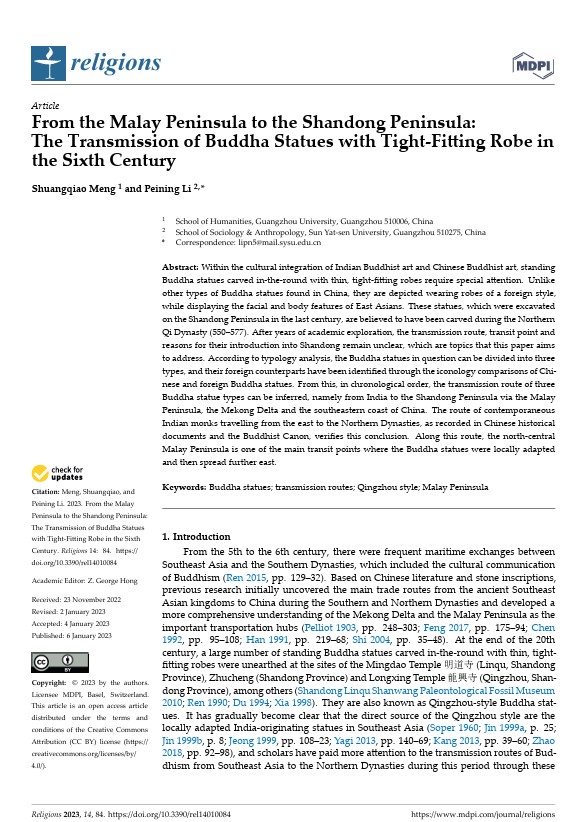|
|
|
|---|

| ชื่อผู้แต่ง | Shuangqiao Meng and Peining Li |
| วารสาร/นิตยสาร | Religions |
| ปี | 2023 |
| ปีที่ | 14 |
| ฉบับที่ | 1 |
| ภาษา | English |
| หัวเรื่อง | พระพุทธรูป |
บทความต้องการชี้ให้เห็นความสัมพันธ์ของกลุ่มพระพุทธรูปแบบคุปตะที่พบในอินเดีย เอเชียตะวันออกเฉียงใต้โดยเฉพาะคาบสมุทรมลายู ปากแม่น้ำโขง และคาบสมุทราซานตง ซึ่งพบว่ามีการเดินทางติดต่อแลกเปลี่ยนกันในช่วงคริสต์ศตวรรษที่ 6
Abstract
Within the cultural integration of Indian Buddhist art and Chinese Buddhist art, standing Buddha statues carved in-the-round with thin, tight-fitting robes require special attention. Unlike other types of Buddha statues found in China, they are depicted wearing robes of a foreign style, while displaying the facial and body features of East Asians. These statues, which were excavated on the Shandong Peninsula in the last century, are believed to have been carved during the Northern Qi Dynasty (550–577). After years of academic exploration, the transmission route, transit point and reasons for their introduction into Shandong remain unclear, which are topics that this paper aims to address. According to typology analysis, the Buddha statues in question can be divided into three types, and their foreign counterparts have been identified through the iconology comparisons of Chinese and foreign Buddha statues. From this, in chronological order, the transmission route of three Buddha statue types can be inferred, namely from India to the Shandong Peninsula via the Malay Peninsula, the Mekong Delta and the southeastern coast of China. The route of contemporaneous Indian monks travelling from the east to the Northern Dynasties, as recorded in Chinese historical documents and the Buddhist Canon, verifies this conclusion. Along this route, the north-central Malay Peninsula is one of the main transit points where the Buddha statues were locally adapted and then spread further east.
พระพุทธรูปศิลปะคุปตะ, Gupta Buddha statue

บทความต้องการชี้ให้เห็นความสัมพันธ์ของกลุ่มพระพุทธรูปแบบคุปตะที่พบในอินเดีย เอเชียตะวันออกเฉียงใต้โดยเฉพาะคาบสมุทรมลายู ปากแม่น้ำโขง และคาบสมุทราซานตง ซึ่งพบว่ามีการเดินทางติดต่อแลกเปลี่ยนกันในช่วงคริสต์ศตวรรษที่ 6
Abstract
Within the cultural integration of Indian Buddhist art and Chinese Buddhist art, standing Buddha statues carved in-the-round with thin, tight-fitting robes require special attention. Unlike other types of Buddha statues found in China, they are depicted wearing robes of a foreign style, while displaying the facial and body features of East Asians. These statues, which were excavated on the Shandong Peninsula in the last century, are believed to have been carved during the Northern Qi Dynasty (550–577). After years of academic exploration, the transmission route, transit point and reasons for their introduction into Shandong remain unclear, which are topics that this paper aims to address. According to typology analysis, the Buddha statues in question can be divided into three types, and their foreign counterparts have been identified through the iconology comparisons of Chinese and foreign Buddha statues. From this, in chronological order, the transmission route of three Buddha statue types can be inferred, namely from India to the Shandong Peninsula via the Malay Peninsula, the Mekong Delta and the southeastern coast of China. The route of contemporaneous Indian monks travelling from the east to the Northern Dynasties, as recorded in Chinese historical documents and the Buddhist Canon, verifies this conclusion. Along this route, the north-central Malay Peninsula is one of the main transit points where the Buddha statues were locally adapted and then spread further east.
พระพุทธรูปศิลปะคุปตะ, Gupta Buddha statue